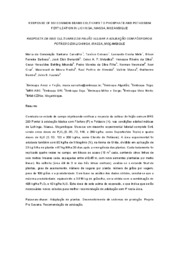Response of six common beans cultivars to phosphate and potassium fertilization in Lichinga, Niassa, Mozambique.
Response of six common beans cultivars to phosphate and potassium fertilization in Lichinga, Niassa, Mozambique.
Author(s): CARVALHO, M. da C. S.; COBUCCI, T.; MELO, L. C.; FERREIRA, G. B.; DENARDIN, J. E.; MATADIUA, C. A. P.; SILVA, H. R. da; MIRANDA, C. H. B.; SILVA FILHO, P. M. da; NEUMAIER, N.; CRUZ, I.; ROCHA, M. de M.; ALMEIDA, R. P. de; MUSSA, V.; DAMBA, G.; KAUNDA, J. B.
Summary: A field experiment was conducted to check out the response of the common bean BRS 293 Pontal to basic fertilization with Phosphorus (P) and Potassium, in the environmental conditions of Lichinga, Niassa, Mozambique. A complete factorial 5x4 was used, with five rates of P2O5 (0, 35, 70, 140, and 280 kg/ha, as Triple Superphosphate) and four rates of K2O (0, 50, 100 and 200 kg/ha, as Potassium Chloride). The experimental area was also fertilized with 90 kg/ha of Nitrogen (N), as Urea, spliced in 23 kg N/ha at planting and 67 kg N/ha 20 days after plants emergency. Each treatment was replicated four time in the field, in randomized blocks (18 m2 each, with five liner of six lineal meters each, spaced 0,45 cm, with nine seeds seeded per meter). At harvest (area of 3 m within the central lines), it was evaluated the plant final stand, degree of lodging, number of pods per plant, number of grains per pod, weight of 100 grains, and productivity. Based in the analysis of the data, it is concluded that maximum productivity, equivalent to 3,616 kg of grains/ha, would be obtained with a combination of 406 kg/ha of P2O5 and 43 kg/ha of K2O. Such rate is above what would be expected, which indicates that new studies would be necessary for better recommendation of P2O5 fertilization in this area.
Publication year: 2014
Types of publication: Paper in annals and proceedings
Unit: Embrapa Rice & Beans
Observation
Some of Embrapa's publications are published as ePub files. To read them, use or download one of the following free software options to your computer or mobile device. Android: Google Play Books; IOS: iBooks; Windows and Linux: Calibre.
Access other publications
Access the Agricultural Research Database (BDPA) to consult Embrapa's full library collection and records.
Visit Embrapa Bookstore to purchase books and other publications sold by Embrapa.

